Ah October, when a young man's thoughts turn to pumpkin carving, Spider-Man costumes and trying to get a lady friend to sport the French Maid look for the evening. We here at BOP have decided that there is no time like the present to compile a list of our fifty favorites horror films for your perusal.
Now, we are not the American Film Institute so we make no claims that this list is anywhere near as important as the work they do. We didn't attempt to compile all of the thousands of contenders and argue their relative merits in order to get the most accurate set of 50 films possible. The reason for this is simple. We're way too lazy and the world has far too many shiny things for that sort of effort. Well, that and the fact that we've seen the A.F.I. work and we realize what a thankless, hopeless task they face. Oversights and arguments of merit largely predicated on taste are the norm.
Rather than deal with the sort of madness which comes with making an Important List, the site managers at BOP decided to shave our selections by borrowing occam's razor (he's dead so he doesn't need it). We simply grabbed a vocal changer and called the 42 members of the BOP staff, breathed into the phone and then asked, "What's your favorite scary movie?" I am now facing indictment in federal courts for telephone harassment and Drew Barrymore has gotten me pushed back another 100 feet with the new restraining order but that's exactly the sort of sacrifice we'll willing to make to bring you the list of BOP's 50 favorite horror movies.
50) I Walked With a Zombie
 This 1943 classic from the team of producer Val Lewton and director Jacques Tourneur (also responsible for Cat People and The Leopard Man) is truly one of the great zombie movies of all time. A nurse is hired to go to the West Indies, but once there finds primitive tribal magic and the walking undead. The B-movie production doesn't hurt this film in the least; creepy atmospherics paint an insubstantial portrait filled with vague shadows and sinister wanton drumming. Also featuring the immortal Darby Jones as the empty-eyed Carrefour, lead zombie. (Chris Hyde/BOP)
This 1943 classic from the team of producer Val Lewton and director Jacques Tourneur (also responsible for Cat People and The Leopard Man) is truly one of the great zombie movies of all time. A nurse is hired to go to the West Indies, but once there finds primitive tribal magic and the walking undead. The B-movie production doesn't hurt this film in the least; creepy atmospherics paint an insubstantial portrait filled with vague shadows and sinister wanton drumming. Also featuring the immortal Darby Jones as the empty-eyed Carrefour, lead zombie. (Chris Hyde/BOP)
49) Riget (The Kingdom) Parts 1 and 2
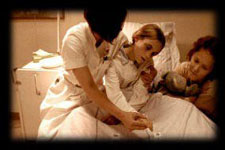 The Kingdom is Lars Von Trier's made for television miniseries. It takes
place in a hospital and eschews most if not all horror movie cliches,
instead relying on a revolving storyline not a million miles away from E.R.
or Emergency!. Instead of George Clooney or Julie London, however, we meet a
cast of Danish actors, most if not all of whom are unknown to American
audiences. There's a lot of humour at the expense of Sweden, Von Trier's
usual predilection for using actors with Downs' Syndrome as his chorus, and
a healthy dose of disturbing supernatural goings on. The effect of the
shifting plotlines is to increase the tension, as the humourous moments are
repeatedly undercut by some genuinely scary bits. Especially disturbing in
Part 2 is a (non-supernatural) subplot about a doctor who wishes his own
terminal cancer to be the subject of experimental surgery. Taken together,
it's a nine hour viewing experience, but I wouldn't cut a single minute! At
one point there was supposed to be a Part Three, but it hasn't happened yet. (John Seal/BOP)
The Kingdom is Lars Von Trier's made for television miniseries. It takes
place in a hospital and eschews most if not all horror movie cliches,
instead relying on a revolving storyline not a million miles away from E.R.
or Emergency!. Instead of George Clooney or Julie London, however, we meet a
cast of Danish actors, most if not all of whom are unknown to American
audiences. There's a lot of humour at the expense of Sweden, Von Trier's
usual predilection for using actors with Downs' Syndrome as his chorus, and
a healthy dose of disturbing supernatural goings on. The effect of the
shifting plotlines is to increase the tension, as the humourous moments are
repeatedly undercut by some genuinely scary bits. Especially disturbing in
Part 2 is a (non-supernatural) subplot about a doctor who wishes his own
terminal cancer to be the subject of experimental surgery. Taken together,
it's a nine hour viewing experience, but I wouldn't cut a single minute! At
one point there was supposed to be a Part Three, but it hasn't happened yet. (John Seal/BOP)
48) Poltergeist
 "They're here." Two simple words, usually completely innocuous. In
Poltergeist, they take on an ominous tone (it was the "I see dead people"
of its day), considering they're coming from the mouth of a five-year-old
girl who's been spending time communicating with the snow on TV. A weird
little girl isn't the end of things, as soon enough, chairs are stacking
themselves, the backyard tree is carrying a grudge and you've got a little
more closet space with that whole 'other dimensional vortex' in there. It
could just be rowdy college kids, but they didn't call it Poltergeist for
nothing.
"They're here." Two simple words, usually completely innocuous. In
Poltergeist, they take on an ominous tone (it was the "I see dead people"
of its day), considering they're coming from the mouth of a five-year-old
girl who's been spending time communicating with the snow on TV. A weird
little girl isn't the end of things, as soon enough, chairs are stacking
themselves, the backyard tree is carrying a grudge and you've got a little
more closet space with that whole 'other dimensional vortex' in there. It
could just be rowdy college kids, but they didn't call it Poltergeist for
nothing.
Probably the definitive suburban horror film, Poltergeist carries a
significant subtext about the rapid expansion of urban sprawl and the
culture of 'profit at any cost'. Mostly though, it's a triumph of stylish
FX (which pretty much hold up today) and although official directing credit
goes to Tobe Hooper of Texas Chainsaw Massacre fame, it's all but been
confirmed that this was Steven Spielberg's baby all along. There's ample
evidence of his handywork. The suburban setting, the focus on children
(Heather O'Rourke gets most of the credit, but Oliver Robbins as the
brother does a terrific job as well), the mix of mysticism and science;
these are all trademarks of 1980s Spielberg.
Some of the scariest horror films are those that use the everyday against
us; it shakes up our comfort level and makes us question our most basic
safety levels. Nothing gets to that faster than the thought that your own
house could be out to get you. As the epitome of this sub-genre,
Poltergeist will remain a classic for years to come. (Reagen Sulewski/BOP)
47) Army of Darkness
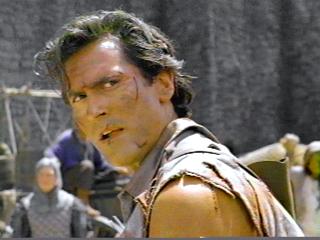 With cultural references as varied as the Three Stooges, Ray Harryhausen, and Planet of the Apes, Army of Darkness falls as much into the categories of comedy, fantasy and science fiction as it does horror. While the first two films in the Evil Dead series were filmed on meager budgets and only gained their cult followings on video, director Sam Raimi was finally able to obtain studio backing from Universal to the tune of $30 million. Nonetheless, Army of Darkness is almost universally considered to be the weakest of the trilogy, an opinion shared even by its director and star (Bruce Campbell), who attribute it to character inconsistencies in Ash, who is a cowardly and clumsy blowhard in the first half of the movie, but suddenly becomes brave and adept by the time the battle with the Deadites begins. Other deficiencies can be attributed to studio intervention; Army of Darkness is considerably less gory than its predecessors, the ending was changed from grim to happy, and some of Raimi's trademark touches were left on the editing room floor
With cultural references as varied as the Three Stooges, Ray Harryhausen, and Planet of the Apes, Army of Darkness falls as much into the categories of comedy, fantasy and science fiction as it does horror. While the first two films in the Evil Dead series were filmed on meager budgets and only gained their cult followings on video, director Sam Raimi was finally able to obtain studio backing from Universal to the tune of $30 million. Nonetheless, Army of Darkness is almost universally considered to be the weakest of the trilogy, an opinion shared even by its director and star (Bruce Campbell), who attribute it to character inconsistencies in Ash, who is a cowardly and clumsy blowhard in the first half of the movie, but suddenly becomes brave and adept by the time the battle with the Deadites begins. Other deficiencies can be attributed to studio intervention; Army of Darkness is considerably less gory than its predecessors, the ending was changed from grim to happy, and some of Raimi's trademark touches were left on the editing room floor
Despite its shortcomings, the film is eminently quotable and generally a lot of fun to watch. From "This is my BOOM stick!" to "Give me some sugar, baby" to "Good, bad, I'm the guy with the gun", Campbell delivers his cornball lines with perfect timing and undeniable aplomb. Even though he becomes larger-than-life by the end of the film, the truth of the matter is that fans identify with Ash because he is an anti-hero and an Everyman; just an ordinary guy thrown into extraordinary circumstances. He's not smart (Klaatu, Barrada, Necktie, anyone?) or classically handsome or even particularly heroic ("Send me back, like in the deal!"), but we root for him anyway because he's outrageously charismatic and hilarious.
Ultimately, Army of Darkness is a categorical B movie. Though it has few real scares, it does have blood and guts, creepy things, cheesy dialogue, convoluted storylines, and an unpretentiousness that seems to bog down some of the heavier and less memorable films of the genre. Viewers also get the chance to see one of Raimi's earliest bigger-budget opportunities; though it precedes Spider-Man by nearly a decade, it's fascinating to see the developing director's work as it relates to the later blockbuster (particularly on the bootleg edition of the DVD, where he and Campbell discuss decisions made throughout the filming of the picture). The movie may not have been a financial success and it certainly wasn't well-received critically, but Army of Darkness is firmly lodged in the consciousness of horror buffs everywhere as a send-up of numerous, MST3K-worthy films that came before it. (Kim Hollis/BOP)
46) Au Rendezvous de la Mort Joyeuse
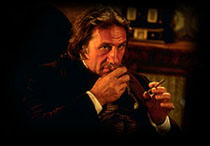 Au Rendez-Vous de la Mort Joyeuse was the directorial debut of Juan Bunuel,
son of Luis. It was a most auspicious debut and one can only wonder what has
kept Bunuel minor from the eyes of discerning film fans. This is an unusual,
slowly paced, but deeply disturbing horror film that delves into some very
dark corners of the human psyche. A prime candidate for rediscovery on DVD. (John Seal/BOP)
Au Rendez-Vous de la Mort Joyeuse was the directorial debut of Juan Bunuel,
son of Luis. It was a most auspicious debut and one can only wonder what has
kept Bunuel minor from the eyes of discerning film fans. This is an unusual,
slowly paced, but deeply disturbing horror film that delves into some very
dark corners of the human psyche. A prime candidate for rediscovery on DVD. (John Seal/BOP)
45) King Kong
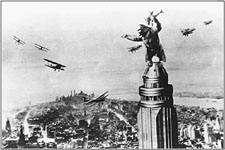 Name anything else that turns 70 next year and still looks good. I thought so. Even those who haven't seen the film are familar with the scene of Kong scaling the Empire State Building, swatting airplanes with one hand and holding Fay Wray in the other from the many times it's been referenced and spoofed by other films. And so it remains one of the most famous scenes from the early days of cinema. Both amazingly solid and landmark for its time, with special effects that
honestly do hold up pretty well today and even rival more modern films (Godzilla, this means you). It won't scare anyone anymore, but this is still one of the most important and best horror movies ever made. (Tim Briody/BOP)
Name anything else that turns 70 next year and still looks good. I thought so. Even those who haven't seen the film are familar with the scene of Kong scaling the Empire State Building, swatting airplanes with one hand and holding Fay Wray in the other from the many times it's been referenced and spoofed by other films. And so it remains one of the most famous scenes from the early days of cinema. Both amazingly solid and landmark for its time, with special effects that
honestly do hold up pretty well today and even rival more modern films (Godzilla, this means you). It won't scare anyone anymore, but this is still one of the most important and best horror movies ever made. (Tim Briody/BOP)
44) Stir of Echoes
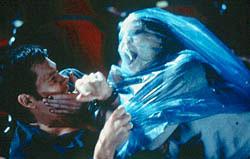 Initially dismissed as a quickie Sixth Sense knockoff (though that wasn't the case at all), this Kevin Bacon film easily stands on its own merits. What makes Stir of Echoes effective as a horror film is its ability to engross a person in its world. Director David Koepp cleverly sucks the viewer into the film with two brilliant scenes that make the scares all the more realistic.
While the story is thin in some places and there are a few loose ends, the tension and atmosphere that encompass Stir of Echoes make it a very scary and chilling film. (Walid Habboub/BOP)
Initially dismissed as a quickie Sixth Sense knockoff (though that wasn't the case at all), this Kevin Bacon film easily stands on its own merits. What makes Stir of Echoes effective as a horror film is its ability to engross a person in its world. Director David Koepp cleverly sucks the viewer into the film with two brilliant scenes that make the scares all the more realistic.
While the story is thin in some places and there are a few loose ends, the tension and atmosphere that encompass Stir of Echoes make it a very scary and chilling film. (Walid Habboub/BOP)
43) The Omen III
There's a string of movies with the Devil or his kid (Mr. Anti-Christ to you) as direct characters, all the way from The Devil and Daniel Webster to Little Nicky, but very few of them really give you the proper feeling of sly, intelligent menace that this one does with Damien Thorn (AKA the Anti-Christ; just look for that 666 birthmark behind the ear), the subject of the previous two Omen movies. Here, he's portrayed - by Sam Neill - as a young man (32) on his way up in the world; multimillionare, US Ambassador to Britain, and the slickest and cruelest little devil you'll ever see.
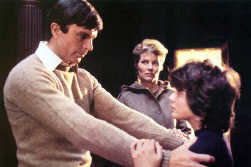 Sam is just fantastic; he has a role that allows him to out-do Richard III in chewing the scenery with naked malice convincingly, and he does it to a fine turn. Frankly, he's worth the price of admission by himself as he fights off the good guys in an effort to discover (and kill) a baby Jesus at the Second Coming. And there's a lot of kinky stuff: Dead babies, dogs, people and you-name-it in the struggle.
Sam is just fantastic; he has a role that allows him to out-do Richard III in chewing the scenery with naked malice convincingly, and he does it to a fine turn. Frankly, he's worth the price of admission by himself as he fights off the good guys in an effort to discover (and kill) a baby Jesus at the Second Coming. And there's a lot of kinky stuff: Dead babies, dogs, people and you-name-it in the struggle.
While the plot has some strains, the back-and-forth between the good and evil forces (priest flambé, mass murder of infants, and a particularly lovely scene where one of Damien's assistants gets his) has some nightmare twists, some unexpected deaths and creepy levels of mental control by Damien, and some very believable and shocking killings and maimings. The Jerry Goldsmith score adds to a real edge-of-your-seat experience. (Jim Rittenhouse/BOP)
42) Candyman
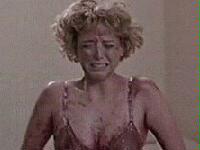 Like many great horror movies, Candyman strives to not only scare you, but to also tackle social issues in the process. Virginia Madsen plays Helen Lyle, a graduate student writing her thesis on urban legends. When a murder in the Cabrini Green housing projects of Chicago is blamed on the mythical Candyman (who can be summoned by saying his name five times), Helen and her
partner head to the project to interview residents and examine the legend. There are plenty of frights and gore to satisfy any horror fan, and Tony Todd truly makes the Candyman a frightening and imposing horror character, but it's the ability to take on issues like race relations (from
the de facto segregation of housing projects to the story of the origin of the urban legend) and tackle the idea of at what point does legend become reality on top of all that (not to mention the score by Philip Glass) is what raises Candyman above the standard slasher film. Though the film was popular enough to spawn two sequels (one of which was direct to video), it still doesn't quite get its due among other recent horror franchises. Candyman, Candyman, Candyman, Candyman, Candy....nope, I still can't do it. (Dan Krovich/BOP)
Like many great horror movies, Candyman strives to not only scare you, but to also tackle social issues in the process. Virginia Madsen plays Helen Lyle, a graduate student writing her thesis on urban legends. When a murder in the Cabrini Green housing projects of Chicago is blamed on the mythical Candyman (who can be summoned by saying his name five times), Helen and her
partner head to the project to interview residents and examine the legend. There are plenty of frights and gore to satisfy any horror fan, and Tony Todd truly makes the Candyman a frightening and imposing horror character, but it's the ability to take on issues like race relations (from
the de facto segregation of housing projects to the story of the origin of the urban legend) and tackle the idea of at what point does legend become reality on top of all that (not to mention the score by Philip Glass) is what raises Candyman above the standard slasher film. Though the film was popular enough to spawn two sequels (one of which was direct to video), it still doesn't quite get its due among other recent horror franchises. Candyman, Candyman, Candyman, Candyman, Candy....nope, I still can't do it. (Dan Krovich/BOP)
41) April Fool's Day
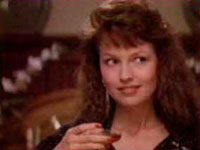 By 1986, the still-new teen-slasher genre had already become mundane and wildly predictable. Rules of the horror film Kevin Williamson would later clearly spell out for his viewers had already become transparent and predictable to those disciples of violence who followed the travails of Freddy, Jason, and Michael Myers.
By 1986, the still-new teen-slasher genre had already become mundane and wildly predictable. Rules of the horror film Kevin Williamson would later clearly spell out for his viewers had already become transparent and predictable to those disciples of violence who followed the travails of Freddy, Jason, and Michael Myers.
Danilo Bach, fresh off the success of the Beverly Hills Cop concept, decided to explore the logic flaws of the genre in a manner which hadn't been tried before. Effectively hiding the key twists of the film in plain sight for viewers (and even in the title), he went on to write a script so brilliant that it had but one flaw: It was a decade too soon to be completely appreciated. The general public simply was not ready for it yet.
When Scream came out in 1996, critics were quick to praise it as an unprecedented idea never before implemented in horror. Unfortunately, few of them will ever know that there does exist an obscure horror flick from the mid-'80s whose only claim to fame is that it starred then-fledgling star Deborah Foreman (of My Chauffeur, Valley Girl and Real Genius), a movie which long ago fell into oblivion but which had the same general idea of tongue-in-cheek teen-slasher violence along with a much better twist ending. (David Mumpower/BOP)
Click here to read selections 31-40.
Click here to read selections 21-30.
Click here to read selections 11-20.
Click here to read selections 1-10.
Click here for an alphabetical list of all selections.

 This 1943 classic from the team of producer Val Lewton and director Jacques Tourneur (also responsible for Cat People and The Leopard Man) is truly one of the great zombie movies of all time. A nurse is hired to go to the West Indies, but once there finds primitive tribal magic and the walking undead. The B-movie production doesn't hurt this film in the least; creepy atmospherics paint an insubstantial portrait filled with vague shadows and sinister wanton drumming. Also featuring the immortal Darby Jones as the empty-eyed Carrefour, lead zombie. (Chris Hyde/BOP)
This 1943 classic from the team of producer Val Lewton and director Jacques Tourneur (also responsible for Cat People and The Leopard Man) is truly one of the great zombie movies of all time. A nurse is hired to go to the West Indies, but once there finds primitive tribal magic and the walking undead. The B-movie production doesn't hurt this film in the least; creepy atmospherics paint an insubstantial portrait filled with vague shadows and sinister wanton drumming. Also featuring the immortal Darby Jones as the empty-eyed Carrefour, lead zombie. (Chris Hyde/BOP)
 The Kingdom is Lars Von Trier's made for television miniseries. It takes
place in a hospital and eschews most if not all horror movie cliches,
instead relying on a revolving storyline not a million miles away from E.R.
or Emergency!. Instead of George Clooney or Julie London, however, we meet a
cast of Danish actors, most if not all of whom are unknown to American
audiences. There's a lot of humour at the expense of Sweden, Von Trier's
usual predilection for using actors with Downs' Syndrome as his chorus, and
a healthy dose of disturbing supernatural goings on. The effect of the
shifting plotlines is to increase the tension, as the humourous moments are
repeatedly undercut by some genuinely scary bits. Especially disturbing in
Part 2 is a (non-supernatural) subplot about a doctor who wishes his own
terminal cancer to be the subject of experimental surgery. Taken together,
it's a nine hour viewing experience, but I wouldn't cut a single minute! At
one point there was supposed to be a Part Three, but it hasn't happened yet. (John Seal/BOP)
The Kingdom is Lars Von Trier's made for television miniseries. It takes
place in a hospital and eschews most if not all horror movie cliches,
instead relying on a revolving storyline not a million miles away from E.R.
or Emergency!. Instead of George Clooney or Julie London, however, we meet a
cast of Danish actors, most if not all of whom are unknown to American
audiences. There's a lot of humour at the expense of Sweden, Von Trier's
usual predilection for using actors with Downs' Syndrome as his chorus, and
a healthy dose of disturbing supernatural goings on. The effect of the
shifting plotlines is to increase the tension, as the humourous moments are
repeatedly undercut by some genuinely scary bits. Especially disturbing in
Part 2 is a (non-supernatural) subplot about a doctor who wishes his own
terminal cancer to be the subject of experimental surgery. Taken together,
it's a nine hour viewing experience, but I wouldn't cut a single minute! At
one point there was supposed to be a Part Three, but it hasn't happened yet. (John Seal/BOP)
 "They're here." Two simple words, usually completely innocuous. In
Poltergeist, they take on an ominous tone (it was the "I see dead people"
of its day), considering they're coming from the mouth of a five-year-old
girl who's been spending time communicating with the snow on TV. A weird
little girl isn't the end of things, as soon enough, chairs are stacking
themselves, the backyard tree is carrying a grudge and you've got a little
more closet space with that whole 'other dimensional vortex' in there. It
could just be rowdy college kids, but they didn't call it Poltergeist for
nothing.
"They're here." Two simple words, usually completely innocuous. In
Poltergeist, they take on an ominous tone (it was the "I see dead people"
of its day), considering they're coming from the mouth of a five-year-old
girl who's been spending time communicating with the snow on TV. A weird
little girl isn't the end of things, as soon enough, chairs are stacking
themselves, the backyard tree is carrying a grudge and you've got a little
more closet space with that whole 'other dimensional vortex' in there. It
could just be rowdy college kids, but they didn't call it Poltergeist for
nothing.
 With cultural references as varied as the Three Stooges, Ray Harryhausen, and Planet of the Apes, Army of Darkness falls as much into the categories of comedy, fantasy and science fiction as it does horror. While the first two films in the Evil Dead series were filmed on meager budgets and only gained their cult followings on video, director Sam Raimi was finally able to obtain studio backing from Universal to the tune of $30 million. Nonetheless, Army of Darkness is almost universally considered to be the weakest of the trilogy, an opinion shared even by its director and star (Bruce Campbell), who attribute it to character inconsistencies in Ash, who is a cowardly and clumsy blowhard in the first half of the movie, but suddenly becomes brave and adept by the time the battle with the Deadites begins. Other deficiencies can be attributed to studio intervention; Army of Darkness is considerably less gory than its predecessors, the ending was changed from grim to happy, and some of Raimi's trademark touches were left on the editing room floor
With cultural references as varied as the Three Stooges, Ray Harryhausen, and Planet of the Apes, Army of Darkness falls as much into the categories of comedy, fantasy and science fiction as it does horror. While the first two films in the Evil Dead series were filmed on meager budgets and only gained their cult followings on video, director Sam Raimi was finally able to obtain studio backing from Universal to the tune of $30 million. Nonetheless, Army of Darkness is almost universally considered to be the weakest of the trilogy, an opinion shared even by its director and star (Bruce Campbell), who attribute it to character inconsistencies in Ash, who is a cowardly and clumsy blowhard in the first half of the movie, but suddenly becomes brave and adept by the time the battle with the Deadites begins. Other deficiencies can be attributed to studio intervention; Army of Darkness is considerably less gory than its predecessors, the ending was changed from grim to happy, and some of Raimi's trademark touches were left on the editing room floor
 Au Rendez-Vous de la Mort Joyeuse was the directorial debut of Juan Bunuel,
son of Luis. It was a most auspicious debut and one can only wonder what has
kept Bunuel minor from the eyes of discerning film fans. This is an unusual,
slowly paced, but deeply disturbing horror film that delves into some very
dark corners of the human psyche. A prime candidate for rediscovery on DVD. (John Seal/BOP)
Au Rendez-Vous de la Mort Joyeuse was the directorial debut of Juan Bunuel,
son of Luis. It was a most auspicious debut and one can only wonder what has
kept Bunuel minor from the eyes of discerning film fans. This is an unusual,
slowly paced, but deeply disturbing horror film that delves into some very
dark corners of the human psyche. A prime candidate for rediscovery on DVD. (John Seal/BOP)
 Name anything else that turns 70 next year and still looks good. I thought so. Even those who haven't seen the film are familar with the scene of Kong scaling the Empire State Building, swatting airplanes with one hand and holding Fay Wray in the other from the many times it's been referenced and spoofed by other films. And so it remains one of the most famous scenes from the early days of cinema. Both amazingly solid and landmark for its time, with special effects that
honestly do hold up pretty well today and even rival more modern films (Godzilla, this means you). It won't scare anyone anymore, but this is still one of the most important and best horror movies ever made. (Tim Briody/BOP)
Name anything else that turns 70 next year and still looks good. I thought so. Even those who haven't seen the film are familar with the scene of Kong scaling the Empire State Building, swatting airplanes with one hand and holding Fay Wray in the other from the many times it's been referenced and spoofed by other films. And so it remains one of the most famous scenes from the early days of cinema. Both amazingly solid and landmark for its time, with special effects that
honestly do hold up pretty well today and even rival more modern films (Godzilla, this means you). It won't scare anyone anymore, but this is still one of the most important and best horror movies ever made. (Tim Briody/BOP)
 Initially dismissed as a quickie Sixth Sense knockoff (though that wasn't the case at all), this Kevin Bacon film easily stands on its own merits. What makes Stir of Echoes effective as a horror film is its ability to engross a person in its world. Director David Koepp cleverly sucks the viewer into the film with two brilliant scenes that make the scares all the more realistic.
While the story is thin in some places and there are a few loose ends, the tension and atmosphere that encompass Stir of Echoes make it a very scary and chilling film. (Walid Habboub/BOP)
Initially dismissed as a quickie Sixth Sense knockoff (though that wasn't the case at all), this Kevin Bacon film easily stands on its own merits. What makes Stir of Echoes effective as a horror film is its ability to engross a person in its world. Director David Koepp cleverly sucks the viewer into the film with two brilliant scenes that make the scares all the more realistic.
While the story is thin in some places and there are a few loose ends, the tension and atmosphere that encompass Stir of Echoes make it a very scary and chilling film. (Walid Habboub/BOP)
 Sam is just fantastic; he has a role that allows him to out-do Richard III in chewing the scenery with naked malice convincingly, and he does it to a fine turn. Frankly, he's worth the price of admission by himself as he fights off the good guys in an effort to discover (and kill) a baby Jesus at the Second Coming. And there's a lot of kinky stuff: Dead babies, dogs, people and you-name-it in the struggle.
Sam is just fantastic; he has a role that allows him to out-do Richard III in chewing the scenery with naked malice convincingly, and he does it to a fine turn. Frankly, he's worth the price of admission by himself as he fights off the good guys in an effort to discover (and kill) a baby Jesus at the Second Coming. And there's a lot of kinky stuff: Dead babies, dogs, people and you-name-it in the struggle. Like many great horror movies, Candyman strives to not only scare you, but to also tackle social issues in the process. Virginia Madsen plays Helen Lyle, a graduate student writing her thesis on urban legends. When a murder in the Cabrini Green housing projects of Chicago is blamed on the mythical Candyman (who can be summoned by saying his name five times), Helen and her
partner head to the project to interview residents and examine the legend. There are plenty of frights and gore to satisfy any horror fan, and Tony Todd truly makes the Candyman a frightening and imposing horror character, but it's the ability to take on issues like race relations (from
the de facto segregation of housing projects to the story of the origin of the urban legend) and tackle the idea of at what point does legend become reality on top of all that (not to mention the score by Philip Glass) is what raises Candyman above the standard slasher film. Though the film was popular enough to spawn two sequels (one of which was direct to video), it still doesn't quite get its due among other recent horror franchises. Candyman, Candyman, Candyman, Candyman, Candy....nope, I still can't do it. (Dan Krovich/BOP)
Like many great horror movies, Candyman strives to not only scare you, but to also tackle social issues in the process. Virginia Madsen plays Helen Lyle, a graduate student writing her thesis on urban legends. When a murder in the Cabrini Green housing projects of Chicago is blamed on the mythical Candyman (who can be summoned by saying his name five times), Helen and her
partner head to the project to interview residents and examine the legend. There are plenty of frights and gore to satisfy any horror fan, and Tony Todd truly makes the Candyman a frightening and imposing horror character, but it's the ability to take on issues like race relations (from
the de facto segregation of housing projects to the story of the origin of the urban legend) and tackle the idea of at what point does legend become reality on top of all that (not to mention the score by Philip Glass) is what raises Candyman above the standard slasher film. Though the film was popular enough to spawn two sequels (one of which was direct to video), it still doesn't quite get its due among other recent horror franchises. Candyman, Candyman, Candyman, Candyman, Candy....nope, I still can't do it. (Dan Krovich/BOP)
 By 1986, the still-new teen-slasher genre had already become mundane and wildly predictable. Rules of the horror film Kevin Williamson would later clearly spell out for his viewers had already become transparent and predictable to those disciples of violence who followed the travails of Freddy, Jason, and Michael Myers.
By 1986, the still-new teen-slasher genre had already become mundane and wildly predictable. Rules of the horror film Kevin Williamson would later clearly spell out for his viewers had already become transparent and predictable to those disciples of violence who followed the travails of Freddy, Jason, and Michael Myers.